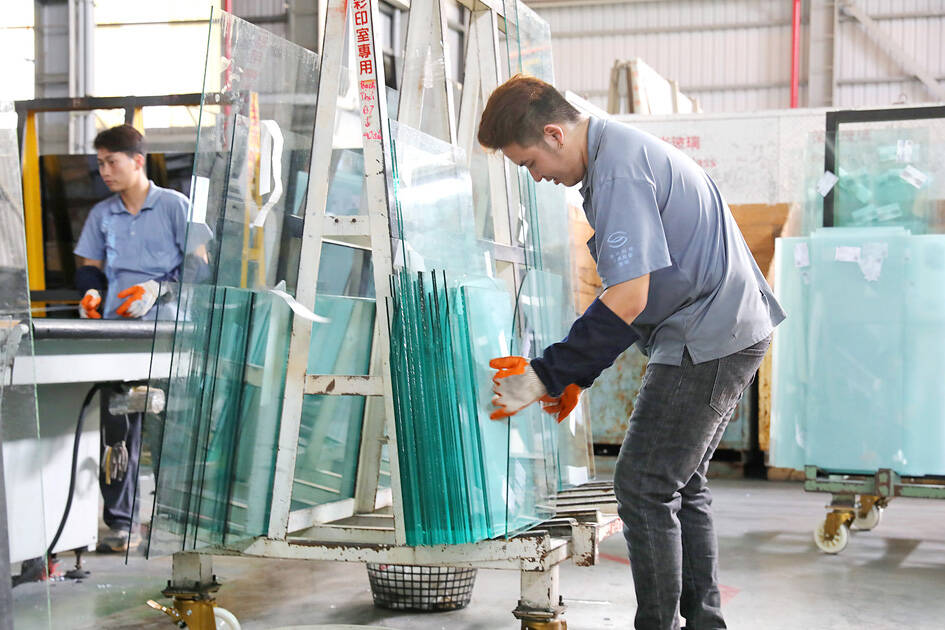The local manufacturing sector returned to expansion last month, as the official purchasing managers’ index (PMI) rose 2.1 points to 51.0, driven by a temporary easing in US-China trade tensions, the Chung-Hua Institution for Economic Research (CIER, 中華經濟研究院) said yesterday.
The PMI gauges the health of the manufacturing industry, with readings above 50 indicating expansion and those below 50 signaling contraction.
“Firms are not as pessimistic as they were in April, but they remain far from optimistic,” CIER president Lien Hsien-ming (連賢明) said at a news conference.

Photo: CNA
The full impact of US tariff decisions is unlikely to become clear until later this month or next, when the 90-day trade truce expires, he added.
However, the temporary pause on new tariffs has prompted companies to accelerate shipments in anticipation of possible new duties, a move that could skew short-term production and order data, he said.
The data showed that manufacturers in the electronics, power equipment and specialty chemical sectors reported improved business conditions, while the automotive sector continued to lag behind.
Despite a rise in rush orders, firms are skeptical the orders would last long, Lien said.
He also said that US President Donald Trump’s potential introduction of differentiated tariffs on advanced versus mature chips could pose a greater threat to Taiwan’s semiconductor exports.
In addition, Trump’s “reciprocal” tariffs are currently facing legal challenges in the US, adding to market uncertainty. As a result, the PMI’s reading for the six-month business outlook remained in contraction territory for the second consecutive month, he said.
Firms indicated that concerns over order visibility are unlikely to ease until the trade truce expires at about July 9, Lien said.
Jerry Pai (白宗城), an advisor at the Supply Management Institute in Taiwan (中華採購與供應管理協會), said that last month’s rebound in the PMI was driven more by supply chain repositioning than demand recovery.
In the services sector, Taiwan’s nonmanufacturing index edged up 0.9 points to 51.9 last month, marking the third consecutive month of expansion, the CIER said.
The increase was supported by a combination of seasonal spending around Mother’s Day and the Dragon Boat Festival holiday, as well as a rebound on the local stock market, it added.
“Despite the short-term resilience, the broader business mood remains cautious,” Lien said, adding that the six-month business barometer rose 10.9 points from the previous month to 40.0 — still firmly in contraction territory.
Much would depend on US tariff decisions and global demand signals over the next couple of months, Lien said.

Taiwan’s long-term economic competitiveness will hinge not only on national champions like Taiwan Semiconductor Manufacturing Co. (TSMC, 台積電) but also on the widespread adoption of artificial intelligence (AI) and other emerging technologies, a US-based scholar has said. At a lecture in Taipei on Tuesday, Jeffrey Ding, assistant professor of political science at the George Washington University and author of "Technology and the Rise of Great Powers," argued that historical experience shows that general-purpose technologies (GPTs) — such as electricity, computers and now AI — shape long-term economic advantages through their diffusion across the broader economy. "What really matters is not who pioneers

In a high-security Shenzhen laboratory, Chinese scientists have built what Washington has spent years trying to prevent: a prototype of a machine capable of producing the cutting-edge semiconductor chips that power artificial intelligence (AI), smartphones and weapons central to Western military dominance, Reuters has learned. Completed early this year and undergoing testing, the prototype fills nearly an entire factory floor. It was built by a team of former engineers from Dutch semiconductor giant ASML who reverse-engineered the company’s extreme ultraviolet lithography (EUV) machines, according to two people with knowledge of the project. EUV machines sit at the heart of a technological Cold

Taiwan Semiconductor Manufacturing Co (TSMC, 台積電) last week recorded an increase in the number of shareholders to the highest in almost eight months, despite its share price falling 3.38 percent from the previous week, Taiwan Stock Exchange data released on Saturday showed. As of Friday, TSMC had 1.88 million shareholders, the most since the week of April 25 and an increase of 31,870 from the previous week, the data showed. The number of shareholders jumped despite a drop of NT$50 (US$1.59), or 3.38 percent, in TSMC’s share price from a week earlier to NT$1,430, as investors took profits from their earlier gains

TAIWAN VALUE CHAIN: Foxtron is to fully own Luxgen following the transaction and it plans to launch a new electric model, the Foxtron Bria, in Taiwan next year Yulon Motor Co (裕隆汽車) yesterday said that its board of directors approved the disposal of its electric vehicle (EV) unit, Luxgen Motor Co (納智捷汽車), to Foxtron Vehicle Technologies Co (鴻華先進) for NT$787.6 million (US$24.98 million). Foxtron, a half-half joint venture between Yulon affiliate Hua-Chuang Automobile Information Technical Center Co (華創車電) and Hon Hai Precision Industry Co (鴻海精密), expects to wrap up the deal in the first quarter of next year. Foxtron would fully own Luxgen following the transaction, including five car distributing companies, outlets and all employees. The deal is subject to the approval of the Fair Trade Commission, Foxtron said. “Foxtron will be